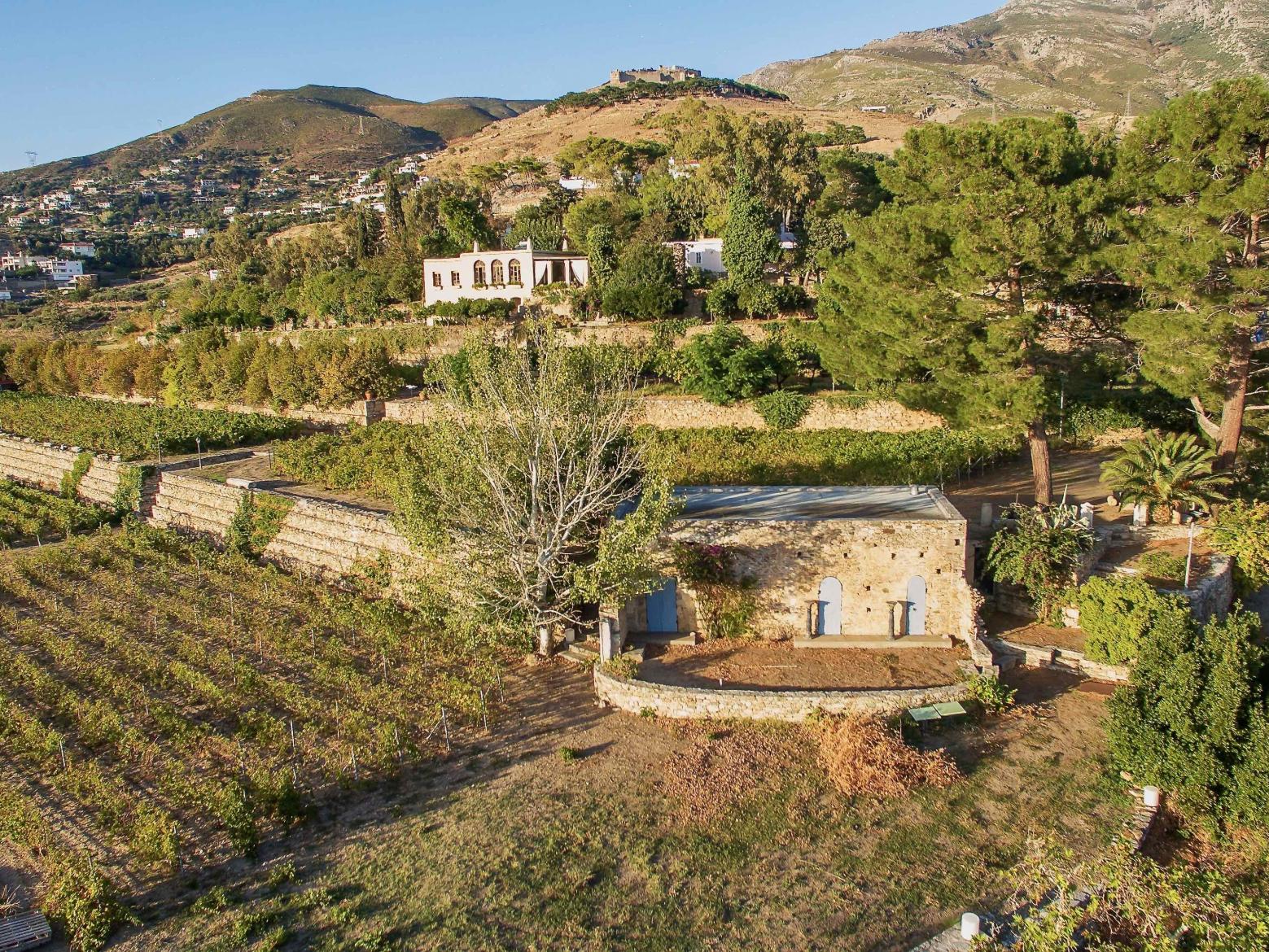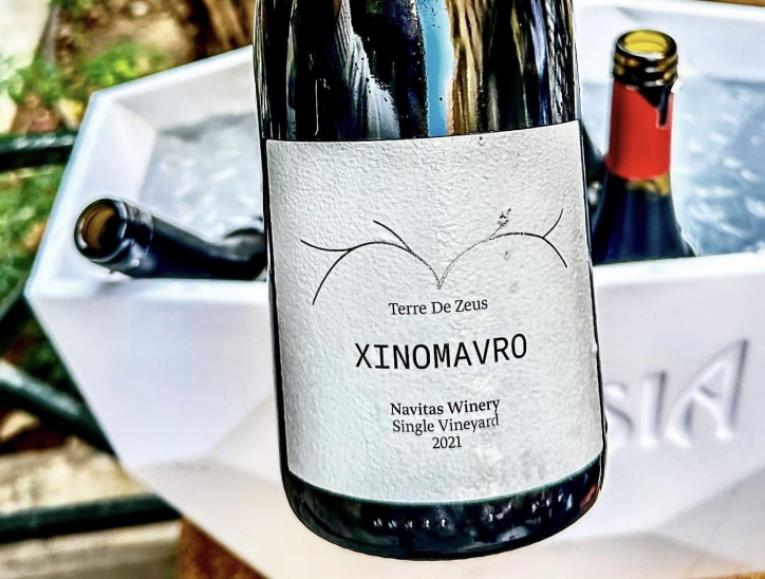Montofoli Estate and their liquid gold elixirs
By Olga Antoniadou
Spending time with Alkmini Karakosta is always such a pleasure. I met her a few years ago when I’d first started my WSET studies, and the specialist wine shops the Karakostas family owns, Cellier, were running tastings. We made instant rapport. Probably because she’s half Greek and half Swedish, or maybe because she’s so warm and cheerful. She’s married to Nikos Chairetakis, an anaesthesiologist specialising in pain management. Since 2020, after her father passed, together they’ve been managing the Montofoli Estate in Palea Chora of Karystos, Evia. She describes it as a magical place of utmost serenity overlooking the Aegean Sea. “There is so much peace and quiet you can understand why so many different ethnicities inhabited it”. This beauty and tranquillity led them to restore the old buildings of the estate and invite all who need some time to heal their souls to stay. “Our motto is: Restore your Spirit”.
I had often thought I wanted to write about the winery, but something else always came up. But, in 2022, their flagship wine Montofoli Estate, 2013 vintage, was awarded 95 points at the Decanter WWA, allowing me to pursue what I had put off so many times. A sun-dried sweet dessert wine made from Assyrtiko, Athiri, Aidani and Liatiko, all grown on the estate (read more on these in the Greek Varieties section of this site). “This wine was actually harvested by my father but bottled by us. This was very moving. Almost as if we connected through what he left behind for us to take further. Like an important piece of timeless artwork that you must save for the generations to follow”. They have a small production of 3-4.000 bottles of their sweet wines, both Montofoli Estate and Montofoli Liatiko, another 2.500 bottles of their rosé Grenache blanc/Muscat Hamburg and white Grenache Blanc and a few more bottles of their red Merlot.
The estate is at 150m elevation, and the vines are grown on wide terraces that cover about 1,3 ha and are planted with Assyrtiko, Athiri, Aidani, Liatiko, Grenache Blanc. There is one row of Pedro Ximénez. They have recently acquired a neighbouring plot of another 1,3 ha that they plan to plant with Assyrtiko. Her father planted the vineyard after 1986 when he bought the relatively deserted and run-down property in a timeless place that has been inhabited since antiquity and has later seen Venetians, Franks, Ottomans and again Greeks. He restored the main building to its initial glory, uprooted the lemon trees, just keeping some, and planted the vines with guidance from Mrs Kourakou and Denis Dubourdieu. Actually, Kourakou suggested the varieties, insisting on Liatiko. “My father wanted to make a sweet wine, a token to Ancient Greece”. These are planted on clay soils. “We get excellent fruit. We are probably helped by the very windy location that doesn’t allow too many insects to thrive and always keeps our vines well-aerated. Imagine that just before harvest time, the wind is so strong it de-leafs the vines, and this helps the fruit ripen well as it is more exposed to the sun”.
As of 2021, talented Gregory Skopelitis has taken over the wine-making, and that is when it was decided to make dry wines from the Grenache Blanc and Liatiko. A very experienced oenologist who has worked at Argyros Estate in Santorini and many other wineries. They farm sustainably, but their vision is to become biodynamic. Even now, they allow sheep to graze on the wild growth between the lines and believe in biodiversity. The vines are irrigated only when necessary, during the summer, from water that flows down the mountain, which is stored. The grapes are hand harvested with many passes through the vineyard. The fruit is sorted, and then for the sweet wines, it is laid out on crates to dry in the sun. The oenologist decides when the grapes are ready to be fermented. The wine is stored in old-use French oak for 5-7 years before being bottled. Their cellar is built next to the 12th-century Catholic Church of St Mark. “We also have space for wine tastings, and when we hold tastings, we usually present wines from many of the producers in Evia because we want the area as a whole to be showcased”.
By now, our lovely coffee was finished, and we both needed to get back to work. I had to pull myself away.
As usual, two wines are tasted.
Myrtilos Rosé Grenache Blanc/Muscat Hamburg: A pink-orange coloured wine with aromas of sweet red berries, citrus zest, some stone fruit and honeysuckle. On the palate, the citrus zest is more intense, with a slight herbal whiff, a medium body with 12,7% abv, with bright acidity and a citrusy finish. A delightful and versatile wine that could pair with several dishes, including salads.
Montofoli Estate 2013 Assyrtiko, Athiri, Aidani, Liatiko: Amber coloured with a browner touch, with intense aromas of caramelised orange zest, dried apricots and dried figs, sultana raisins, grand Marnier coffee, caramel, honeycomb and sweet spices. On the palate, a combination of fresher lemon and forest red berry flavours together with the dried fruit, caramel, grand Marnier coffee, honeycomb, and spice flavours add to the complexity; the amazing acidity balances the sweetness of the wine, and the 16% abv is well integrated, and what length! I could have mistaken this for a Santorini Vinsanto wine, if it weren’t for a very slight reddish hue and those red berry flavours on the palate. I fell in love with this wine, and its price of 32 euros is a steal.





